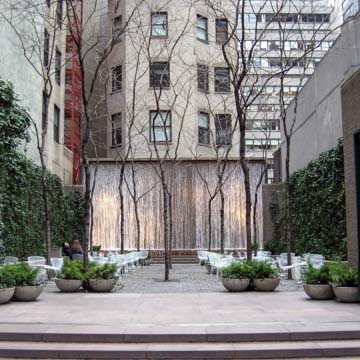You are here
Samuel Paley Plaza
Opened in 1967, Samuel Paley Plaza is a small gem of a park built on the site of the historic Stork Club. It was commissioned by William S. Paley, chairman of CBS, in memory of his father, Samuel Paley. The elegance and simplicity of this vest-pocket park (so called because of its size) set a high bar for a new park form and the concept of an urban amenity built on private property and open to the public—a harbinger of the POPS (privately owned public spaces) of the late twentieth century.
Paley commissioned the landscape architecture firm Zion and Breen Associates to design the space, and worked closely with the firm on every detail, down to the choice of hotdogs sold. The park is open to 53rd Street, and enclosed by buildings on three sides. The 42 x 100–foot lot is set back from and slightly elevated above the street grade, creating a serene and intimate space. A 20-foot-tall wall of rushing white water at the rear of the park on the north side creates both a visual anchor and a sound barrier that screens the street noise, allowing for an interior atmosphere that enhances the sense of refuge from the midtown congestion and noise.
The east and west brick walls are covered in dark English ivy, which also absorbs noise, provides relief from the dominant hardscape, and shelters small birds. The ivy is planted in long, raised, stone-clad beds that provide additional seating. Set into the paved granite floor, a grid of honey locusts creates dappled shade, color, and movement. Large pots of seasonal plants add color, but the overall ambiance is subdued and minimal. The Harry Bertoia–designed wire-mesh side chairs and Eero Saarinen–designed tulip tables (both white) can be rearranged by visitors around the park space. A food kiosk is discreetly tucked inside the entrance; it stands adjacent to the iron gate that closes the park off from the public after hours. Even when the park is closed, the interior and water wall remain visible to passersby on the street.
The park was featured in William H. Whyte’s film, The Social Life of Small Urban Spaces. Whyte lauded the easy access from the sidewalk, the convenience of the park to the surrounding office workers, and the pleasant shade created by the trees that extend over park. He also noted the ways in which seating could be modified by moving the chairs to allow for groups of visitors to gather in their own configurations. The film helped to make Paley Park a model for vest pockets across the nation.
Maintained by the William S. Paley Foundation, Paley Park remains frequently used by workers and visitors in the busy midtown neighborhood, with people stopping for lunch or for a brief retreat from the visual and audible chaos of the street.
References
“Great Public Spaces of New York.” Project for Public Spaces. Accessed March 2, 2017. www.pps.org.
Johnson, Jory, and Felice Frankel. Modern Landscape Architecture: Redefining the Garden. Abbeville, New York, 1991.
Writing Credits
If SAH Archipedia has been useful to you, please consider supporting it.
SAH Archipedia tells the story of the United States through its buildings, landscapes, and cities. This freely available resource empowers the public with authoritative knowledge that deepens their understanding and appreciation of the built environment. But the Society of Architectural Historians, which created SAH Archipedia with University of Virginia Press, needs your support to maintain the high-caliber research, writing, photography, cartography, editing, design, and programming that make SAH Archipedia a trusted online resource available to all who value the history of place, heritage tourism, and learning.

